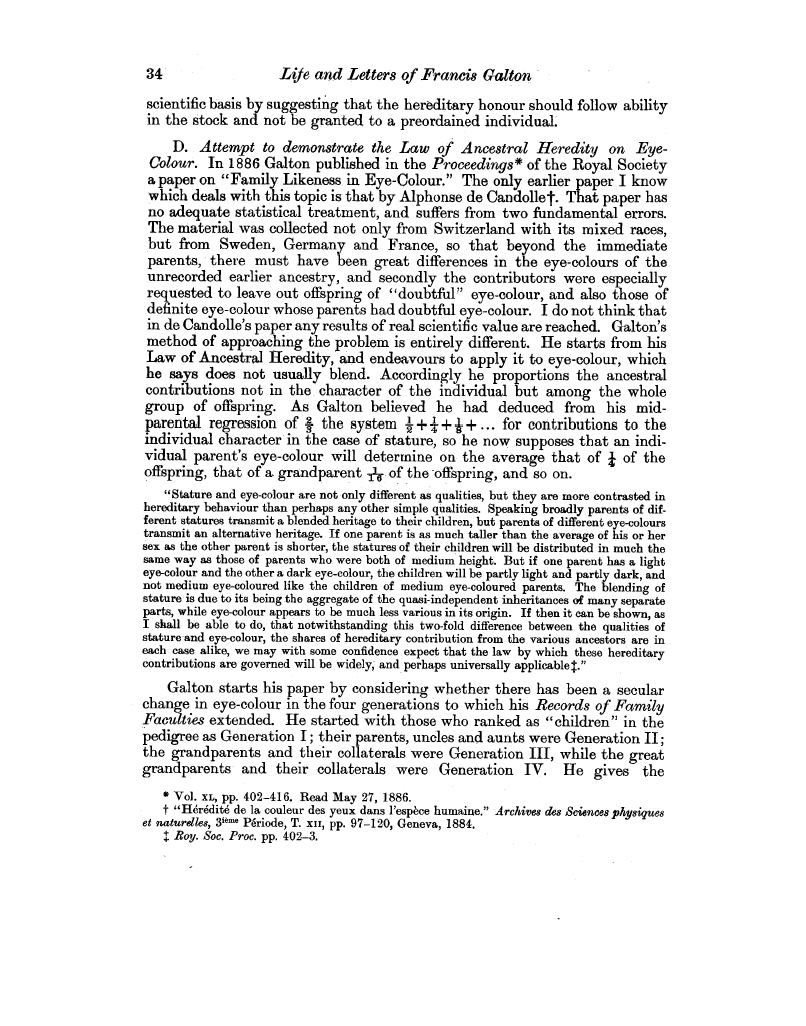| ||||||

OCR Rendition - approximate
34 Life and Letters of Francis Galton scientific basis by suggesting that the hereditary honour should follow ability in the stock and not be granted to a preordained individual. D. Attempt to demonstrate the Law of Ancestral Heredity on EyeColour. In 1886 Galton published in the Proceedings* of the Royal Society a paper on "Family Likeness in Eye-Colour." The only earlier paper I know which deals with this topic i& that by Alphonse de Candollet. That paper has no adequate statistical treatment, and suffers from two fundamental errors. The material was collected not only from Switzerland with its mixed races, but from Sweden, Germany and France, so that beyond the immediate parents, there must have been great differences in the eye-colours of the unrecorded earlier ancestry, and secondly the contributors were especially requested to leave out offspring of "doubtful" eye-colour, and also those of definite eye-colour whose parents had doubtful eye-colour. I do not think that in de Candolle's paper any results of real scientific value are reached. Galton's method of approaching the problem is entirely different. He starts from his Law of Ancestral Heredity, and endeavours to apply it to eye-colour, which he says does not usually blend. Accordingly he proportions the ancestral contributions not in the character of the individual but among the whole group of offspring. As Galton believed he had deduced from his midparental regression of 2 the system 2 + 4 + -+ ... for contributions to the individual character in the case of stature, so he now supposes that an individual parent's eye-colour will determine on the average that of a of the offspring, that of a. grandparent ]?T- of the -offspring, and so on. "Stature and eye-colour are not only different as qualities, but they are more contrasted in hereditary behaviour than perhaps any other simple qualities. Speaking broadly parents of different statures transmit a-blended heritage to their children, but parents of different eye-colours transmit an alternative heritage. If one parent is as much taller than the average of his or her sex as the other parent is shorter, the statures of their children will be distributed in much the same way as those of parents who were both of medium height. But if one parent has a light eye-colour and the other a dark eye-colour, the children will be partly light and partly dark, and not medium eye-coloured like the children of medium eye-coloured parents. The blending of stature is due to its being the aggregate of the quasi-independent inheritances of many separate parts, while eye-colour appears to be much less various in its origin. If then it can be shown, as I shall be able to do, that notwithstanding this two-fold difference between the qualities of stature-and eye-colour, the shares of hereditary contribution from the various ancestors are in each case alike, we may with some confidence expect that the law by which these hereditary contributions are governed will be widely, and perhaps universally applicable." Galton starts his paper by considering whether there has been a secular change in eye-colour in the four generations to which his Records of Family Faculties extended. He started with those who ranked as "children" in the pedigree as Generation I; their parents, uncles and aunts were Generation II; the grandparents and their collaterals were Generation III, while the great grandparents- and their collaterals were Generation IV. He gives the * Vol. XL, pp. 402-416. Read May 27, 1886. t "Heredite de la couleur des yeux dans 1'espece humaine." Archives des Sciences physiques et naturelles, 3ieme Periode, T. xii, pp. 97-120, Geneva, 1884. $ Roy. Soc. Proc. pp. 402-3.
|